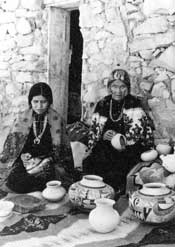Hopi Unusual Polacca Polychrome Jar by Nampeyo [SOLD]
+ Add to my watchlist Forward to Friend
- Category: Historic
- Origin: Hopi Pueblo, Hopituh Shi-nu-mu
- Medium: clay, slip, pigment
- Size: 4-1/2” height x 10” diameter
- Item # C3869B SOLD
 Polacca is a village at the base of First Mesa on the Hopi Reservation, a location where potters secured clay for making pottery. Pottery made from that clay from the mid- to late-1800s has been designated Polacca Polychrome and it is identifiable because of its yellow color and crazing after firing. Crazing looks like a dry river bed where the mud breaks up into small sections, or perhaps a closer analogy would be an egg that has been cracked. The clay does not chip off but develops surface crazing.
Polacca is a village at the base of First Mesa on the Hopi Reservation, a location where potters secured clay for making pottery. Pottery made from that clay from the mid- to late-1800s has been designated Polacca Polychrome and it is identifiable because of its yellow color and crazing after firing. Crazing looks like a dry river bed where the mud breaks up into small sections, or perhaps a closer analogy would be an egg that has been cracked. The clay does not chip off but develops surface crazing.
Nampeyo of Hano, in the late 1800s, secured clay from the area and made pottery on which she applied designs she witnessed from earlier Polacca Polychrome shards. She used those prehistoric designs as inspiration for her new creations.
This jar is of a vessel shape closely allied with Nampeyo. The rim of the jar rolls outward with just a slight curve, almost indistinguishable. The design is unique. It does not appear to be documented in any published collection so it is probably a design developed by Nampeyo from another design from which she improvised.
The stacked lines near the mid-section are arranged in black, red, black. Those nearer the rim of the jar are stacked red, black, red. This is something Nampeyo would have created from her own artistic mind and not something another less creative potter would have considered. Nampeyo was an artistic genius whose pottery constantly amazes us today, over a hundred years later.
Collectors might shy away from a jar such as this Hopi Unusual Polacca Polychrome Jar by Nampeyo because it does not display designs typically associated with Nampeyo, in their judgement. There is no typical design that one should associate with Nampeyo as she was too creative to repeat designs which could then come to be associated with her. It is the rare and unusual designs that speak her name to us and remind us what an artistic genius she truly was. These late 1800s jars with Polacca clay reflect Nampeyo creating what she wished to see, unencumbered by what trader Thomas Keam might have influenced her to do. She was an artist doing what an artist should do.
Condition: very good condition with two slip cracks on underside, minor rim chip
Provenance: from a gentleman from Oregon
Recommended Reading: Canvas of Clay: Seven Centuries of Hopi Ceramic Art by Wade and Cooke
The photograph above shows Nampeyo of Hano on the right with her daughter Fannie on the left - ca. 1930, courtesy of Rick Dillingham Fourteen Families In Pueblo Pottery.
- Category: Historic
- Origin: Hopi Pueblo, Hopituh Shi-nu-mu
- Medium: clay, slip, pigment
- Size: 4-1/2” height x 10” diameter
- Item # C3869B SOLD



